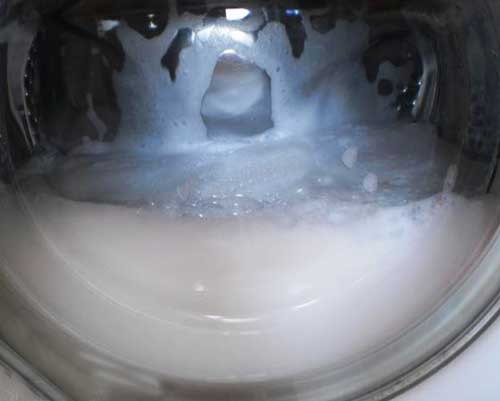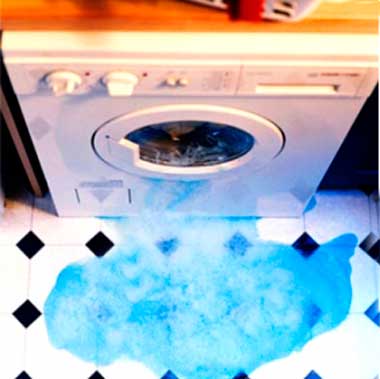What's the main reason your washing machine is so full of foam?
There are situations in life when you walk into the bathroom and see that the washing machine is all foamy. "Why?", "How did this happen?", "What to do?" - these are the first questions that come to your mind.

The first thing you should do is to turn off the power to the washing machine. If a lot of foam has formed while the washing machine is running, it can get into the electronic parts of the machine and easily put them out of action. Therefore, we stop the washing and drain the water through the hole at the bottom of the machine. Usually in the lower right corner there is a hatch, if you open it, the excess water will pour out, but it is better to put a rag before opening it, so as not to cause a flood in the bathroom.
Next - we take out the laundry. Use your hands to remove all the remaining foam in the drum and turn on the rinse. If there is a lot of foam, it may not all come out of the machine at the first rinse. Therefore, if it did not work the first time, put the rinse until there is no foam left in the machine at all.
After performing these simple operations, you should analyze the causes of excessive foam in the washing machine:
- Very often it is due to the powder.

What to do if there is foam? - This can happen when using a cheap powder with a low content of defoamers, or if you got a counterfeit.
- You may have put in hand-washing detergent, which you shouldn't, because it's not designed for that. Make sure you check it out!
- Very often housewives put too much powder, thinking that it will wash very dirty laundry better. This is a mistake. Laundry detergent should be poured exactly as much as the manufacturer recommends. If your machine is in working order, it will cope with any dirt and with the recommended amount of powder.
- When washing lightweight and bulky items, you need less powder. Curtains, tulle, soft voluminous things themselves additionally whip up a lot of foam in the machine. All this works on the principle of "sponge". Our advice is to use the special products strictly according to the instructions, or use less powder (the dosage can be reduced by almost half).
- Often the cause of abundant foaming is soft water. This usually occurs either when you move to a new home, or when you install filter water softener. The less foam is produced the harder the water is. The opposite is also true - soft water produces a lot of foam. If this applies to you, reduce the amount of powder by one-third and you will be fine.
What if it's exactly the same as it was yesterday and a week ago? Why is this happening if nothing has changed: the same powder, the same amount, the same water and the same things?
With a high degree of probability, it can be argued that the cause of the formation of abundant foam is some kind of malfunction.
The most common reasons why your washing machine ends up all foamy
Foam that comes out of the washing machine when washing, can signal many causes: from the usual clog to a leaky unit. Therefore, it is better to entrust a specialist to identify the causes of malfunction.
| Symptoms of failure | Probable cause | The price of the service |
| Washing machine in the foam, around the water | Most often, does not hold the rubber gasket of the hatch. This happens both because of poor-quality rubber and because of improper use. Often the sealing rubber gets damaged from small objects caught in its folds, which have not been removed from the pockets. It happens that the seal is torn from the sudden closing of the hatch, with the accumulation of water in it - there is a pinch and tear. The place of the tear depends on where the foam is coming from: if from the outside - then through the hatch, and if from the inside - from the bottom of the machine. |
From $9 |
| Water and foam around the machine | Such a symptom indicates that the fault, most likely, in the water drainage system.
As a rule, in this case, the branch pipe is damaged or the fastening of the hose for the drain is loose. This requires inspection of the entire drainage system: pump, drain hose, pipe, filter, as well as the place of connection of the drain hose to the drainage outlet. The goal is to determine the cause of the leak. Tighten wherever necessary, re-tighten loose parts, and/or replace damaged parts. For example, a loose drain hose clamp should be tightened, and if the drain hose is damaged, only a complete replacement will help. |
By yourself or from $6. |
We think now you understand why a lot of foam sometimes forms when washing. And the ways to fix these defects are not very serious and, accordingly, not too expensive. Therefore, you should not postpone the repair "in a long box", because the small breakdown can entail a more serious, and then you will have to pay a pretty penny. Believe me, repairing the control board or the motor costs a lot more! Often the cost of such a repair is comparable to the cost of ½ a washing machine.




